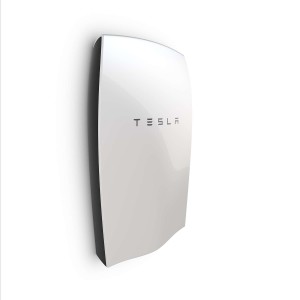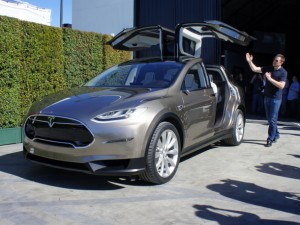A common concern about the “greenness” of electric vehicles is that the batteries have a negative environmental footprint, from manufacturing to disposal. True, batteries have an environmental cost, but it is minimal over the lifecycle of the vehicles compared to the alternative of a petroleum-fueled vehicle (of course, the true alternative of walking, biking or transit is the ideal, if not always practical for most people).
But there is also a huge environmental upside to the battery: the prospect of hundreds of thousands of used, cheap batteries available to bottle surplus renewable energy for later use. As David Roberts on Vox.com described:
In four or five years, the batteries in the roughly one and a quarter million EVs currently on the road are going to start to wane. EV owners will either replace them, or replace the cars entirely.
That means we’ll have a lot of used batteries on our hands — batteries with plenty of life left in them, but which are no longer suitable for EVs. What to do?
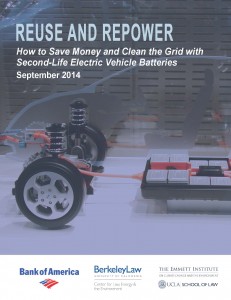 It’s worth reading the article in full for an overview. Or you can see our UC Berkeley/UCLA Law report on the subject back in 2014, Reuse and Repower: How to Save Money and Clean the Grid with Second-Life Electric Vehicle Batteries.
It’s worth reading the article in full for an overview. Or you can see our UC Berkeley/UCLA Law report on the subject back in 2014, Reuse and Repower: How to Save Money and Clean the Grid with Second-Life Electric Vehicle Batteries.
A lot has happened since that report came out, particularly with pilot projects. For example, as the MIT Technology Review reported, BMW combined batteries from 100 cars for a grid-scale energy storage facility in Hamburg, Germany, which is capable of storing 2.8 megawatt-hours of energy and delivering up to two megawatts of power. It’s designed to meet periods of peak demand to avoid having to ramp up fossil-fueled power plants. And a French web hosting company in Normany is deploying used Nissan EV batteries to capture surplus renewables to lower energy costs. These are just a few of the growing number of pilot projects happening around the world.
And studies on the subject are increasingly bullish. Fortune covered a new report this past summer from Bloomberg New Energy Finance, which predicts that roughly a third of electric car batteries are expected be reused by 2025, totaling 29 gigawatt hours of used batteries. 10 gigawatt hours of those could be repackaged for grid needs.
But the challenges are myriad. Greentech Media has a great article describing the barriers and options going forward, many of which we discussed in our 2014 report:
“Batteries are a lot like people: They each have their own individual state of health depending upon what they’ve been exposed to and how they’ve been treated over the course of their life,” said Ken Boyce, who’s developing a safety standard for second life batteries at Underwriters Laboratories, a major safety certification firm.
But despite the potential and progress being made, one major automaker is notably absent in these efforts: Tesla. As the Bloomberg New Energy Finance report author Claire Curry observed in Greenwire [paywalled]:
Tesla, however, is not one of the players, partly because it is more interested in recycling batteries at its Gigafactory in Nevada, Curry said.
“Tesla has so much stationary storage capacity it needs to sell,” she said.
I asked Elon Musk about his interest in used EV batteries in early 2014 at a public event, and he said he was absolutely in favor. His staff later approached me to walk back his comments a bit. It seems that they want to make money selling new batteries and don’t want the competition from cheap used ones.
But Tesla may be swimming against the tide, as a surge in used EV batteries could change the energy storage market and clean the grid for the better — starting in just a few short years.
In Fortune, former Tesla VP Cristiano Carlutti dishes on the company and the upcoming Model 3 (Tesla’s first mass-market EV, due in 2017):
As far as the downsides of the Tesla Model 3, let’s try to look at things from a different perspective: the biggest downside of Model 3 in my opinion is that it doesn’t exist yet. Lots of things can change until the launch date and I would assume that, when it was presented earlier this year, Model 3 was probably nowhere near a decent stage of development.
In order to understand this perspective, you have to take a different look at the way the company operates: in my opinion, it’s fundamentally a very focused marketing machine that until now has been focused on selling shares, with car sales instrumental to that. Before some fans attack me because of this comment, let me tell you that… it was the right thing to do!
In other words, Elon perfectly knew since the beginning that he would need a massive amount of money to become a car OEM and that, in order to raise that money, he had to create and sustain excitement in investors even more than in clients. Another way to look at it is that at this prices, the purchase of Tesla stock is more irrational than the purchase of a Model S: the latter is a very good car, competitive in its market, while the stock is more of a bet (or a gamble) on future dividends that nobody knows if they will ever appear. Car sales and car fans are just instrumental to raise the money Tesla needs to reach the point where it will be self-sustainable: the gamble is that financial markets keep drinking the company’s kool-aid at least until the company becomes self-sustainable. If they stop drinking it too soon, it will be game over and an historical failure, if believers sustain the company long enough, it will be a masterpiece of entrepreneurship and a tremendous success.
A lot is at stake with the future of Tesla. The company is, in my view, the most important private sector clean technology purveyor out there. Elon Musk has almost single-handedly pushed EVs to the forefront of the public imagination, spurring other automakers to follow suit. He also is betting big on energy storage and its marriage with solar PV, which will be essential to decarbonizing the grid. Combined with electric transportation, Tesla’s technology deployment promises to help the world decarbonize at a much greater rate than we otherwise would.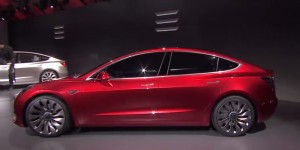
I don’t want to overstate it, but Tesla is making a strong claim to being in position to quite literally save the world (at least from out-of-control climate change).
So we need the company to succeed and raise the capital it needs for the deployment it envisions. If Carlutti is to be believed, let’s hope Musk can keep stoking the imagination of investors — and more importantly, that he and his team can deliver on their big promise with the Model 3. They’ll need a car that meets expectations at the right price and delivery time, without some of the quality issues plaguing the Model S.
It’s possible to do, but not certain. Reason for us all to be nervously optimistic.
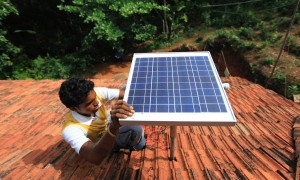 Just like the developing world has leapfrogged wealthy countries with telecommunications — jumping right to cell phones over land lines — it may be doing the same with clean electricity grids.
Just like the developing world has leapfrogged wealthy countries with telecommunications — jumping right to cell phones over land lines — it may be doing the same with clean electricity grids.
Greenbiz reports on some of the microgrids being deployed in developing countries like Haiti, involving solar, some energy storage, and “internet of things” monitoring and control for customers. Essentially, the software can deploy specific amounts of electricity to individual customers based on their needs, like lighting and television watching. If they don’t pay, they lose service, but can restore it the next day if they have the money:
“We started with the idea that the poorest people in the world make the shrewdest financial decisions,” said [business owner] Thakkar. And he believes they have proved their point.
“Our first customer was an old gentleman in a small village. Everyone in the village came out to listen to our presentation. He asked two or three questions and then went back in his hut and came out with 1,000 rupees, which was the equivalent of about $20. He said, ‘Great, give it to me,'” he recalled of the 2008 start of the company.
The big difference in these low-income markets is that many customers just want basic electricity service for things like lights and charging phones. Obviously, developed markets have much more intense electricity needs.
But by scaling the market at this initial step, we’re learning what works and what doesn’t. And as costs come down and the business model proves itself, it could become a model that scales to the developed world. While the vision of communities going completely off grid may still be impractical or too expensive, these developing world examples show that we can get pretty far along that path. And with new technological breakthroughs, it could one day even enable a complete break with the traditional grid model even in the developed world.
It’s a question I’ve asked myself since Tesla made a splash with its “Powerwall” concept. It sounds super clean tech, after all: rooftop solar plus a battery feels like a 100% clean energy solution and a way to say goodbye to the utility.
But battery prices really aren’t low enough yet to be practical for this kind of use, and most solar PV arrays can’t generate enough power throughout the year to allow consumers to go completely off grid.
So we mostly hear about batteries as a backup option or for providing other grid services. Certainly batteries paired with solar (or standalone) can make a lot of sense for certain business customers, because they can get hit with incredibly high demand charges at certain times of the billing cycle. A battery that kicks in to supply power during those moments, rather than having the customer continue to draw power from the grid, can therefore save a lot of money.
But the same rates don’t apply to residential customers. Yes, homeowners typically face higher rates the more electricity they use in a billing cycle, but they don’t experience sudden huge charges, seemingly at random times. If they did, and they could program a battery to kick in during those moments, the cost of the battery would surely pencil over time.
Yet there are some exceptions. Residential customers with solar PV who live in states like Hawaii or Nevada with reduced rooftop solar incentives may need to get battery backups to enhance or rescue their solar PV investment. But even then, the economics probably don’t work so well.
And perhaps the biggest exception: those who want backup power in case of outages. If you live in an area prone to blackouts or in a remote area with fragile or even no access to the grid, or if even a single blackout would cause significant damage or disruption, backup power of some kind could make a lot of sense. Batteries could help meet that backup power need. But still: it’s so much cheaper and easier to simply get a diesel generator.
With this thought process in mind, I’ve largely dismissed the potential market for residential backup battery storage. So I was interested to read about a battery company representative who says his company makes most of its sales precisely on supplying backup power. Greentech Media reported on battery maker Sonnen, and a recent presentation from senior technical trainer Greg Smith:
This is an emotional sell, totally an emotional sell,” Smith said. “You get this system… [that’s] keeping your refrigerator on, so you get cold beer, you’ve got your phones that are charging so you’re connected to the world, and you can have lights. It’s a comforting thought.”
Lithium-ion batteries are relatively new for the home-use market, and concepts like self-consumption and time-of-use electricity rates are still confusing to a lot of people. Everybody understands the concept of backup power, however, and that use case tends to resonate with residential customers.
Sonnen took that and ran with it. The company website prominently displays the pitch “Never worry about the lights going out” as a reason to buy. It has discovered evocative and emotionally resonant case studies, like that of an elderly woman whose Sonnen battery kept her house powered when the rest of her neighborhood had gone dark. She invited everyone over to charge their phones and drink lemonade. That sense of safety and security doesn’t fit neatly into the ledgers.
But what about diesel generators as a cheaper alternative?
Lithium-ion can also do certain things the incumbents can’t. It’s got a smaller footprint, cleaner chemistry and longer cycle life than lead-acid batteries. And, unlike diesel generators, it doesn’t belch pollutants into the air and subject its owners to a clamorous din while operating.
More crucially, though, diesel generators still rely on diesel, and the kind of situations that knock out power for days on end also tend to shut down gas stations. Case in point: the nuclear reactors in Fukushima melted down not because of earthquake damage, but due to loss of power that shut off the reactor cooling mechanisms. The plant’s diesel generators failed to save the day because they were flooded by the tsunami, which also washed their diesel fuel tank out to sea. A diesel generator alone does not guarantee resilience.
It also can’t keep solar panels running. Customers who have batteries paired with rooftop solar installation enjoy an entirely different outlook. Grid-tied rooftop solar shuts down when the grid cuts out, but Sonnen’s home energy system isolates itself in a temporary microgrid. That allows the solar modules to recharge the battery each day, and it keeps the home operating at a 21st-century standard of living until grid power is restored.
It’s an interesting counter example of success in backup power, but in some ways it proves my point. Batteries still have to be an “emotional sell,” and there will necessarily be limits to the size of that kind of market, if the numbers aren’t there. As Greentech Media noted just a few days after running this story, the market may be as small as just 2 percent of customers, based on a recent survey.
Still, an emotional appeal can matter. And more importantly, as states around the country scale back rooftop solar incentives and as battery prices continue to drop, my guess is we’ll see this market grow from tiny to potentially quite lucrative.
And in the end, more energy storage like batteries, sprinkled around the grid, will help us meet our goals for a low-carbon electricity system, while saving customers money at the same time. We’re just not quite there yet.
ARPA-E just might save the world. And you probably never heard of it. As I wrote back in January 2015 (okay, I’ll just quote myself here):
Why is ARPA-E so important? Because this Department of Energy group is searching out and funding those moonshot — or sunshot — technologies that will give us the energy breakthroughs we need to fight climate change. If we’re going to find the better battery to finally wean us off oil and into electric drives, or build the cheap energy storage device to capture surplus renewables and truly decarbonize the grid, or make our solar panels even more efficient and cheap, chances are ARPA-E will be involved in making that happen.
Now the agency, on the occasion of its seventh birthday, is releasing a report detailing some of its successes. Per Utility Dive:
Since 2009, ARPA-E has provided $1.3 billion in funding to more than 475 projects. Of those, 45 have gone on to raise $1.25 billion in publicly-reported private sector funding.
…
“ARPA-E fills a critical gap in the innovation ecosystem, investing to de-risk and accelerate the development of high risk, high impact technologies that would otherwise find it difficult to secure investment,” said Jesse Jenkins, a researcher and doctoral candidate at the Massachusetts Institute of Technology.“This is an essential role for government to step into, helping bridge the ‘technological valley of death,’ a consistent dearth of private sector funding that impedes the translation of promising research into commercial technologies,” he added.
The article describes a few examples, particularly with battery systems and other energy storage technologies. These funded projects include hybrid fuel cells, zinc-air batteries, as well as flywheels and a vegetable-based flow battery developed by Harvard researchers.
This is the kind of agency that the federal government should be funding to the brim, especially with this impressive track record on deployment. It’s also one of the critical issues at stake between a Trump or Clinton victory this fall. If we want to continue on this path and fund the breakthrough clean technologies of the future, the choice is clearly for Clinton.
And in the meantime, the success to date for ARPA-E is a big credit to President Obama and the agency staff. Let’s hope they continue the momentum, as the health of the planet depends on it.
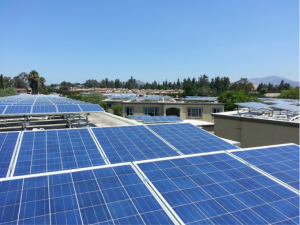 Utilities may hate rooftop solar for cutting into their profits, but they seem to like community solar. In these arrangements, consumers buy into a local solar PV project that could be small enough to fit on a Little League field. The local utility buys the electricity and then reduces the customers’ electric bills based on how much the utility purchases.
Utilities may hate rooftop solar for cutting into their profits, but they seem to like community solar. In these arrangements, consumers buy into a local solar PV project that could be small enough to fit on a Little League field. The local utility buys the electricity and then reduces the customers’ electric bills based on how much the utility purchases.
This is a great option for renters and apartment dwellers who don’t have their own roof space and therefore no access to their own solar arrays.
Bloomberg reports on the new wave of community solar taking off like rooftop did:
“Utilities see community solar as a bit more friendly,” said Drew Warshaw, vice president of community solar at NRG Energy. “By definition we have to use their transmission and distribution system, we pay for any upgrades needed and they continue to have a relationship with the customer.”
Still, utilities are closely watching how this initiative plays out, mainly related to lost revenue, according to Chief Executive Officer Jim Torgerson of Avangrid Inc., which owns utilities in New York and New England.
“Shared solar has much better economies of scale than rooftop but net metering issues really have to get resolved,” he said in a phone interview. “We think it’s worth the wholesale price of power, not the retail rate.”
Even with this utility hesitancy, the future for community solar seems brighter than for rooftop, given the more pro-utility bent of the contracts. So right now utilities may be okay with the arrangement.
But it may just be a matter of time before the technology improves enough to displace traditional large-scale utilities. As solar and battery prices come down, many communities will be able to essentially become their own utilities, with links to neighboring microgrids.
If that comes to pass, community solar may hasten the end of the traditional utility.
 Navigant’s William Tokash envisions the possibilities with the proposed SolarCity-Tesla merger:
Navigant’s William Tokash envisions the possibilities with the proposed SolarCity-Tesla merger:
A key aspect of technology innovation in renewable energy has been financing innovation. The development of power purchase agreement financing has been instrumental in the growth of solar PV. Navigant Research believes that financing innovation will also drive energy storage markets over time, as well. But the new Tesla could be uniquely positioned to apply financing innovation to an integrated solar battery PEV-based VPP [virtual power plant] while also providing consumers with the use of the vehicle. Imagine a homeowner entering into a 15-year financing agreement for solar, energy storage, and use of a Tesla Model 3 under a single contract. In this scenario, the new Tesla/utility partner manages the VPP asset while the customer gets access to, but not ownership of, a Tesla Model 3.
This financing arrangement could spark a real breakthrough in deploying more clean technologies. The issue for climate and clean tech, as Jigar Shah recently wrote to Bill Gates, is less about technology innovation at this point and more about how we actually start getting these technologies financed and built.
The proposed merger could get us farther down that road than we’ve been before, at least for home and business solar+storage, coupled with EVs in the garage.
I’m back from vacation, and while a lot has happened since I was away, the big story seems to be the unveiling of Tesla’s 2.0 master plan — at least on the environment and energy front. The key stand-outs for me are:
- The diversity of transportation modes that Tesla wants to electrify: It’s not just about passenger vehicles anymore, as Tesla wants to build buses and cargo trucks, too. And of course, the expansion into pickup trucks and compact SUVs are noteworthy.
- Autonomous driving will take a while: Musk writes that while the technology is being tested, regulatory policies are still way behind, especially taking into account all the jurisdictions around the globe. He anticipates another 5 years or so before fully autonomous vehicles are allowed everywhere.
- The big play on residential and commercial batteries for solar: the new acquisition of SolarCity has solidified this approach, but the master plan is clearly betting on solar incentives changing across the country. Right now it’s a pretty good deal to get rooftop solar in most places, but there are no incentives to capture surplus solar in a battery as long as customers are getting full retail credit from their utility for it. Musk seems to betting that retrenching these incentives, as Nevada and Hawaii have done, will become the norm and will therefor provide an opportunity for batteries. It could also set up Tesla as a bit of an opposition force to traditional solar installers in these state battles, as those companies generally don’t want solar incentives shifted to batteries.
I’ll have more thoughts soon in particular on the Tesla play for buses and transit. But in the meantime, Musk has given the public a lot to chew on.
The proposed merger between Tesla and SolarCity has a lot of Wall Street types grumbling. But as I wrote a few weeks ago, the deal makes some sense in the short run and has the outside potential for major gains unlike anything we’ve seen in the energy space.
Now the Chicago Tribune spells out some of the specifics of the upside for the company, much of which is predicated on likely policy changes to solar policy in the U.S.:
Net metering rules, which require electric utilities to buy back rooftop solar from customers at retail rates, are the biggest U.S. subsidy for solar power. But as solar power spreads, the policy will begin to destabilize grid economics. Several states have reversed their rules already, most notably Nevada, where the abruptness of the turnabout left customers in the lurch with overbuilt solar systems and no way to recoup costs. Higher-capacity battery storage will eventually allow solar customers to profit from their solar systems with or without net metering. It’s investment security for the homeowner.
Essentially, Tesla is betting — with good reason — that states will likely start encouraging battery installation along with solar panels.
The article also notes that Tesla may be able to aggregate all of its customers’ battery power to sell this flexible resource to the wholesale electricity market to provide various grid services, distributing the revenue to its customers in the form of reduced energy bills or cash payments.
My only quibble is that the “frequency regulation” market that the article cites is lucrative but relatively small. So the company may have better success aggregating all this flexible demand to be responsive to grid needs (essentially to match renewable generation).
So in the near term, Tesla can benefit by selling solar panels in its showrooms. In the medium term, it can bet on battery incentives in many states and the possibility of aggregating all of its customers’ energy resources to sell to grid operators. And in the long run, as costs continue to decline and new technologies become available, the company could very well supplant traditional utilities by managing all of your energy — and transportation — needs.
Not a bad play, all in all.
As has been widely reported, Tesla is making moves to buy solar installer SolarCity. The two companies have family relations, with Elon Musk’s cousins running SolarCity and with Musk serving as chairman of the board, in addition to his role running Tesla.
Does the deal make sense? At a basic level, yes (although doubts persist about the short-term economics). Tesla is already distributing its batteries through SolarCity, and many Tesla customers will be interested in solar, once their electricity bill goes up as they charge at home. So there are obvious synergies: — Tesla can advertise for SolarCity in their showrooms for example, and SolarCity can promote Tesla vehicles and batteries.
But in the long term, Musk is aiming for a monopoly on a magnitude we’ve rarely if ever seen before, outside of the old company town. Essentially, Tesla seeks to own your transportation and home energy, all in one corporate clean energy “ecosystem.” It will become your utility, car company, and gas station, all in one — only without the emissions of our current system.
Musk is a friend and former business partner of Peter Thiel, the famed PayPal investor who preaches the virtues of such monopolies. Thiel essentially argues that if you’re an entrepreneur starting a business that isn’t aimed at becoming a monopoly, you’re basically wasting your time. Think Google and Amazon.
It’s hard to argue with the pure business logic of that approach (leaving aside the traditional arguments against monopolies). And now Musk seems to be following through on that approach with this takeover effort — a monopoly pattern that already started with Tesla’s decision to own its own charging network, rather than let third party companies take over, and to bypass auto dealers in favor of direct sales. At least from an environmental perspective, it would certainly herald a big win.
But will it work? Not in the short term. SolarCity will not be replacing electric utilities anytime soon. And batteries plus solar will not allow most people to leave the grid entirely. You simply can’t generate enough power or store it to cover most people’s needs throughout the year. And many people don’t own their own homes or have their own rooftops to make this possible.
But two trends could change that dynamic. First, technologies can improve, leading to more powerful solar panels and cheaper, bigger batteries. New technologies, such as cheap fuel cells, could also provide the additional generation needed to fill the solar gaps during the nighttime and winter. These developments could allow Tesla/SolarCity to become the ultimate monopoly it dreams of, particularly if it can operate at a neighborhood scale for those without dedicated rooftops.
Second, Tesla/SolarCity could buy up other companies to fill the gaps, such as energy efficiency companies and different renewable generators, like urban wind turbine manufacturers.
All in all, it’s a big gamble but with a very logical long-term goal. In the short term, the co-marketing and co-distribution opportunities could cover the costs of the merger. And in the long term, it has the outside chance of turning this country into the United States of Tesla, whether we like it or not.

